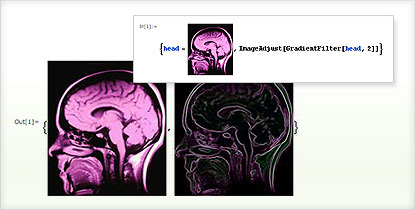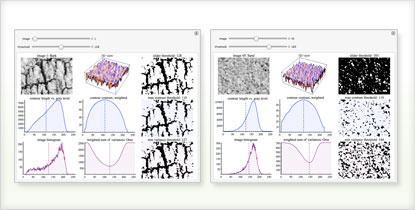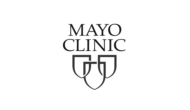The Wolfram Solution for Medical Imaging
Use built-in functions for segmentation, registration, restoration and analysis of 2D and 3D volumetric images; prototype new algorithms quickly and efficiently; and deploy tools as standalone or web-based applications—from one system.
The Wolfram medical imaging solution provides a complete integrated workflow for image processing and application development, with the speed and performance benefits of GPU computation, parallel processing and out-of-core technology.
- The Wolfram Edge
- How Wolfram Compares
- Key Capabilities
Wolfram technologies include thousands of built-in functions and curated data on many topics that let you:
- Design software programs to do edge-preserving smoothing, denoising, sharpening and other enhancements
- Visualize tomography data in 2D or 3D such as CT and MRI scans
- Slice through 3D data and explore the inside of a volume
- Create pattern-recognition algorithms for computer-aided diagnosis or tumor detection
- Develop and simulate radio-frequency pulse sequences
- Compare imaging measurements with biological models
- Scan cell samples for abnormalities
- Study videos of runners to improve the efficiency of their movements
- Deblur CT slices and remove inhomogeneities from MRI backgrounds
- Capture and process images from imaging devices in real time
- Analyze fiber orientation in lab-grown tissue to determine its strength
- Use noninvasive techniques to study the heart, reducing risk to the patient
- Deploy web applications for remote diagnosis


Does your current tool set have these advantages?
-
Complete, integrated image processing workflow in a single document
Matlab requires purchasing extra toolboxes for image processing and opening multiple windows to work with multiple images -
Extensive built-in image processing functions on any platform
ImageJ requires downloading and installing plug-ins created by varied sources for full functionality; OsiriX is only available for macOS systems -
Procedural, functional and rule-based programming paradigms, plus easily recognizable function names, create an efficient programming environment
Matlab and other programs use primarily procedural languages, creating longer code and use abbreviated function names that provide no intuitive indication of their meaning -
Conveniently drag and drop images directly into the input line to apply image processing functions
Unique to Wolfram technologies -
Integrated environment for interactive visual workflow
C, C++ and other languages require you to switch between a graphical window and text input to visualize and process images


Medical imaging specific capabilities:
- Efficient and powerful programmability for batch processing of images, interpreting proprietary data formats, quickly prototyping new image processing algorithms and more »
- Binary, morphological and other image segmentation algorithms for identifying shapes and regions, along with functions for shape and color analysis of image features »
- Mathematical morphology transforms and analysis, including finding branch points, skeletons, distance transforms and more »
- Immediate detection or extraction of features such as edges, corners and general keypoints for registering and comparing images »
- Efficient implementations of image processing algorithms for 3D images or datasets »
- Built-in 3D volumetric rendering engine »
- State-of-the-art linear and nonlinear image processing filters for smoothing, sharpening, removing noise and more »
- Thousands of built-in functions for processing digital image intensity and color data »
- Calculus and linear algebra functions to solve differential geometry problems such as edge detection and curvature calculations
- Import, export and convert hundreds of formats, including DICOM, FITS and HDF »
- Easily build interactive interfaces to instantly visualize the effects of image manipulations like adjusting contrasts, enhancing edges or applying filters »
- Out-of-core technology for scaling up performance to very large 2D and 3D volumetric images »
- Support for GPU computation with CUDA or OpenCL, including built-in functions for pixel operations, morphological operators and image convolution and filtering
- Discrete or continuous high-performance wavelet analysis for thresholding and visualizing in any dimension »
- Histograms, array plots and list density plots to visualize image data »
- Connect to Java image processing libraries or integrate with existing C/C++ code
Consulting Solutions
Enlist the world’s computation experts to help with your project—any size, any level. At Wolfram, we know what’s possible with computational technology because we are global leaders in creating it. That gives us an unprecedented depth of expertise in applying it to consulting work in a variety of fields. Whether individual or enterprise, from concept to deployment, our computation experts can help you achieve robust results with less time and effort. Get us started with your project today



